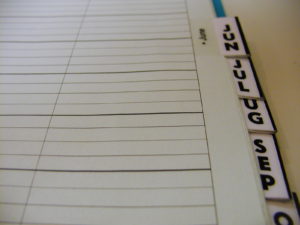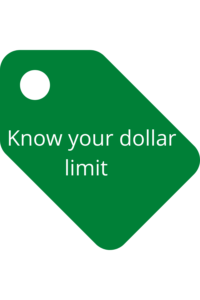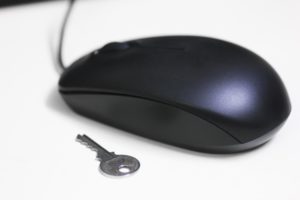How to Save For Something Big
Buying a big-ticket item is usually expensive and can be a financially challenging event. Where’s the money for it going to come from? You need a plan: Knowing how much it will cost and how many paydays you’ll have before you need to make the purchase will give you the basic information you need to save for expensive items. Knowing how to save for something big is essential to making frugal purchases and saving money.
Of course, if you are saving for something big, you need to include it in your budget.
Keeping track of how much you need and how much you have is a huge advantage to being able to make this purchase and not finance it. Yes, there are benefits to budgeting.
The Easy Way To Save For Something Expensive Is To Plan For It
Your goal is to have sufficient funds to cover the cost of the item by the time you want to make your purchase. A sinking fund is an excellent way to achieve that goal. Sinking funds are installment savings with a dedicated purpose, a series of predetermined deposits to your savings account that can be expressed as a cost/time ratio. Essentially, a sinking fund is your own “payroll savings plan” set up in anticipation of making a major purchase. Sinking funds provide an easy and convenient way to save the money you need for such events.
How To Save For Something Big And Expensive
A sinking fund is a great plan for accruing the funds needed for a large purchase. If you work the plan correctly, you can save a lot of money painlessly. What makes this an extraordinary plan is that it’s easy to implement. You save fixed amounts of money at fixed intervals from your paychecks. You’ll be familiar with the market for the product you’re buying, so it’s quite possible you’ll find some latitude in pricing. And you’ll avoid financing fees. Not having to pay loan application fees and/or interest is a huge plus.
The Plan
As with any financial endeavor, you’ll want to do some research and define the project:
- Determine the attributes of the item you want to purchase—do some research, shop around
- Find the most expensive and least expensive retailers that carry the item
- Save as if you plan to buy from the most expensive retailer—purchase it from the least
- One week before you buy the item, call around to find out if it’s likely to go on sale soon
- Make the purchase
Know What You Want to Buy
It’s important to know what you’re looking for. Whatever the item is shop around for it; you can do this in brick-and-mortar stores or online. Find out what the important features and qualities of the item are and how they vary from brand to brand. When you consider various brands, be sure you are comparing items with similar features like size, speed, or convenience, and for most of us, price is a major factor.
For example, I’m going to say you’re looking for a big-screen TV:
The first thing you need to know is what size TV will fit in the space you have for it. Next, start thinking about the brand you’d like to buy. Talk to people you know who already have a large-screen television. Your friends will probably be very frank about things like the picture and sound quality, resolution, and other factors that contribute to or detract from their enjoyment of watching TV. Pay attention to those detractors. With regard to big-screen TVs, one that many people forget is how far from the screen you need to be for the best view. So, not only do you need wall space for the TV, you need a room that accommodates the view. Don’t forget to talk to sales reps; they have knowledge of the latest technology trends. Online reviews are also good to read.
Shopping Tip 1
While you’re doing your research, keep good notes. If you visit many stores (or online sites), you’ll want to keep track of all the pertinent information about where you saw what in a way that’s easily accessible. When I’m planning to buy something big, I use 3×5 cards to jot down details I need to remember from each place I visit. That eliminates confusion as to what I saw where and how much it costs. (BTW: When you note prices, record the full price, not special or sale prices. If you need to save in order to buy something, it’s likely the sale will end before you’re ready to make the purchase.)
Shopping Tip 2
Just as you should ask questions about features and qualities, you should ask about pricing; there may be add-ons that complete your purchase. Will you need extra equipment? Off the top of my head, when buying a television, I think a mounting unit and a cable or two may be required. Usually, those are separate purchases, but you’ll need them when it’s time to set up. Will there be similar requirements for the item you’re planning to buy? Include any needed accessories and their prices in your notes.
At times you may encounter extra charges: Delivery and set-up fees are fairly common. Will you be charged for those services? What about insurance? Taxes always need to be included in your pricing and depending on where you live, they might be charged on services as well as goods.
As you shop, ask about fees and additional components. Some retailers may offer package deals for accessories. Others will charge for each individually. Also, the price and quality of some types of required add-ons may vary. (You usually want to go for quality at the lowest available price.)
The price of any add-ons should be included when you tally costs.
Shopping Tip 3
It’s possible you’ll begin your search for a big-screen TV (or another item) with some preconceived ideas about what you want. After you’ve done some research, you might find some of those are impractical or just not the best for you. If that’s the case, now’s the time for revision. The cost could be a factor in this: You may find it’s best for your budget to scale back your expectations. On the other hand, perhaps you underestimated the cost and can afford to get more than you anticipated. Other possibilities are adjusting the size of your deposits into your sinking fund—up or down. That will change the number of deposits you need to make before you purchase your item; smaller contributions could require you to give yourself more time to accumulate the funds you need.
(Note: I’ve been talking about buying a big screen Ts as an example, but the principles for finding a good buy will apply to any purchase.)
Pricing The Item
The first part of this post has been devoted to the importance of shopping around to find the right make and model of the big (major, expensive) item you want to purchase and to its cost. If we’re honest with ourselves, most of us have at least a general idea of what we can afford before we even get started. Prices influence our choices; we almost can’t help but notice them. And since we always want value for our money, I’m sure that as you shop for your item, you’ll notice that a variety of venues offer the version you settled on. Those retailers may be selling the same thing, but I’m sure their prices vary—maybe widely.
After you know the brand and model or version of the item you want, look through your notes to find the most expensive and the least expensive place it’s sold (and I mean the whole package, including associated costs—delivery, taxes, etc.). Make sure what’s offered is essentially an identical product, just at differing prices. This will help to prevent buyer’s remorse. There’s nothing worse than making a large purchase and spending a lot of money, only to learn you could have bought the same thing somewhere else for less.
There’s a second reason to know how high the price could be for the item you’re planning to buy: This is the amount you want to have in your sinking fund when it’s time to make your purchase. You also want to know where you can find it least expensively. That’s where you’ll actually buy it. (Quality for your money…) And it doesn’t hurt to have a buffer in place; if you need to save a while, there’s an outside chance the price could go up. Alternatively, if your savings surpass your real cost, once your purchase is made, you can find a use for any leftover funds. (I’d suggest adding them to a sinking fund you have for something else and shortening the amount of time it will take to accumulate the amount of money you need, whatever it’s dedicated to.)
Start Seeing the Money Grow
Once you know the most you’d be likely to spend if you bought it now, you can start saving to meet the more expensive price of the item you want to buy. You’ll make your deposits into your general savings, but be sure to track the value of this sinking fund—and any others—within the whole. (A spreadsheet works well.) Seeing the total regularly increase can be very gratifying and reinforce your incentive to keep saving towards your goal.
How Much per Payday Do I Need to Save
The answer can be very simple. Divide the largest price by the number of paydays between now and when you plan to make your purchase. That figure is how much you need to save each payday. For example, let’s say you’re planning to make a $1000 purchase a year from now, the formula would be
$1000/52=$19.24
Ideally, you’ll put $20 a week into your sinking fund for this project. Now, let’s say you bring home $600 a week…The question is can you afford to set aside that $20? Maybe, after looking at your budget, you see that you can save $40 a week and make your purchase in six months. But what if you can’t afford the $20? Could you save $10 a week for two years? Or is this purchase something that needs to be deferred? So, the answer is very simple, but it has to be an amount that works for you. (BTW: There are ways to bolster income. A part-time job is one.)
Sometimes there may be other mitigating circumstances. Many people have one pay period a month that has more demand on it than the others. That week, it may not be possible to save the same amount as on the others. It’s OK to have an amount you put away monthly rather than weekly. You can divvy the amount up any way you need to. The object is to save on a regular basis, in a timely way, to avoid financing when you plan to buy something big—and sinking funds are a good way to do that.
A Final Price Check
About a week before it’s time to make your planned purchase, call around and confirm the price. You want to get the best deal available and make sure you don’t need to save for a few more pay periods. Ask if the item is likely to go on sale in the near future. If so, get what information you can: dates and sale price. If it is going on sale soon, seriously consider waiting to buy it; take advantage of the opportunity for extra savings.
Make the Purchase
When the time comes to make your big purchase, go for it! And no, when you start saving money in a sinking fund, you don’t really write your purchasing date in stone. Your intent is to have the financial means to do it by a certain date. Essentially, you make payments to yourself, and when you take your purchase home, it’s yours to have, own, use, appreciate, to enjoy— payment (and interest) free.
My Take
I got hooked on using sinking funds to prepare for larger purchases years ago. It’s a good feeling to walk away with an expensive item knowing you won’t face a long period of paying for it. (That’s behind you.) You know, someone I was encouraging to try this plan once asked me (Are you ready for this??) what did I do after I made my purchase with the money I no longer needed to save?! The short answer is, of course, “Anything I want.” A more correct answer would be “Whatever needs to be done.” That was an odd question, but there are other questions I’m frequently asked that I’ll share with you…
Can I Buy Online
You sure can. More and more purchases are being made online. All the shopping and saving principles will be the same on-or-offline.
Where Should I Keep the Money While I’m Saving
Most of the time, I recommend depositing it to an easily accessible savings account. I give complete details in my article “How to use sinking funds”.
If I Find It on Sale, Should I Finance It
How badly do you NEED this item? Or is it something you just really want? I never recommend using credit. Financing is an easy way to get bind and, possibly, legal trouble. I rarely say this, but if you miss a payment to yourself, who cares? (You should.) But, if you miss a payment to a loan company, it could become everybody’s business.
How Can I Save for Something Expensive
Sinking funds are an ideal way to save for something expensive. You’ll save money in interest payments, and you’ll be a well-informed buyer. The use of sinking funds is the process I describe in this post.
Can a Kid Use Sinking Funds
Sure. The saving process in this article is a good learning tool for children. They can learn to save money and to be patient. If the child has a savings account, go ahead and acquaint them with the idea of using it in part for regular, dedicated deposits (from an allowance, cash gifts, or earnings). If he doesn’t have one, a dedicated piggy bank could work. Either way, introduce him to the concepts of saving for a purpose, saving regularly, and tracking his progress. (BTW: Do you remember that early in this post, I said this plan was both easy and simple? Well, it is… Even kids can use it.) Knowing how to save for something big or how to save for something expensive is usually the same thing.







